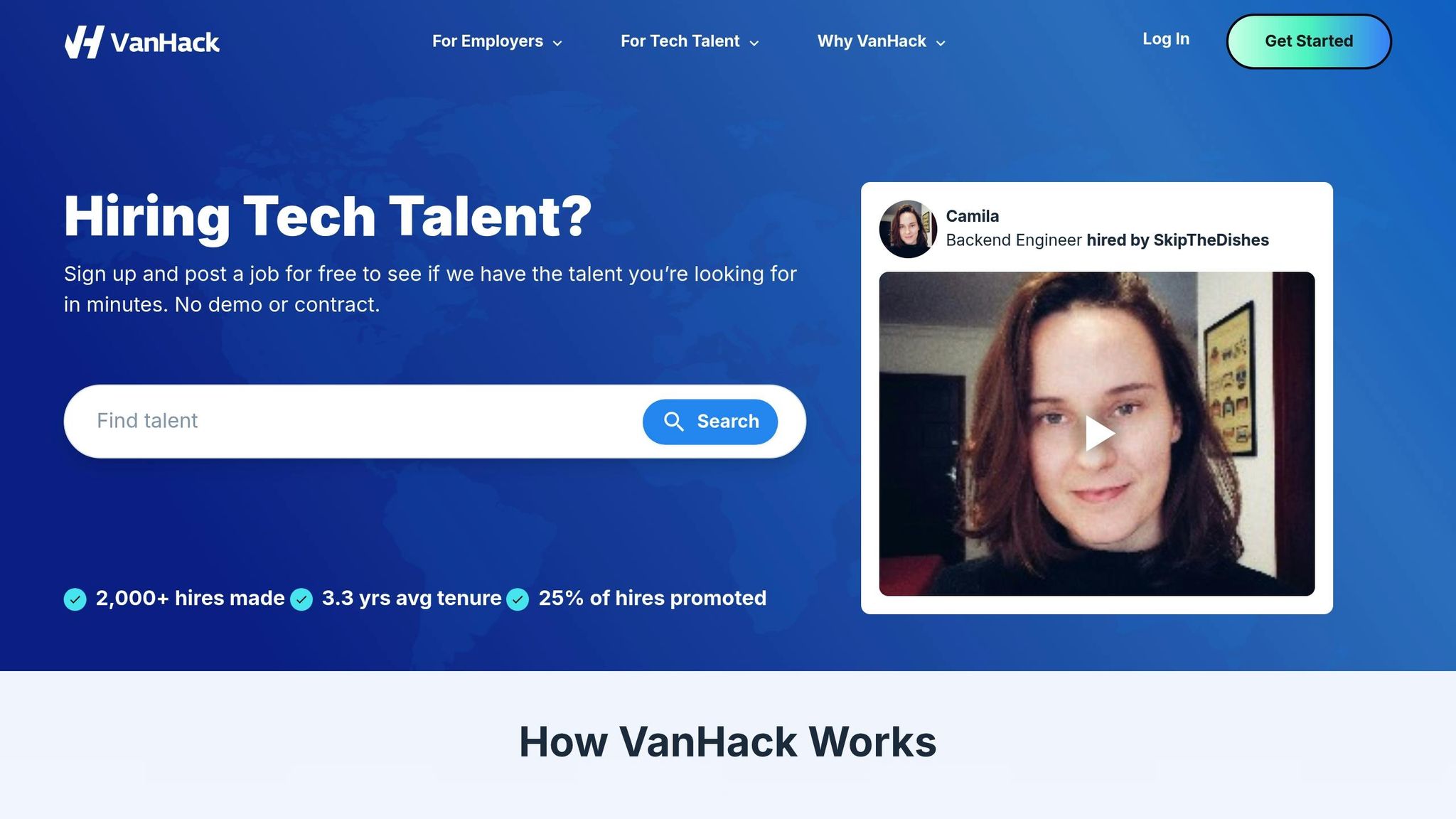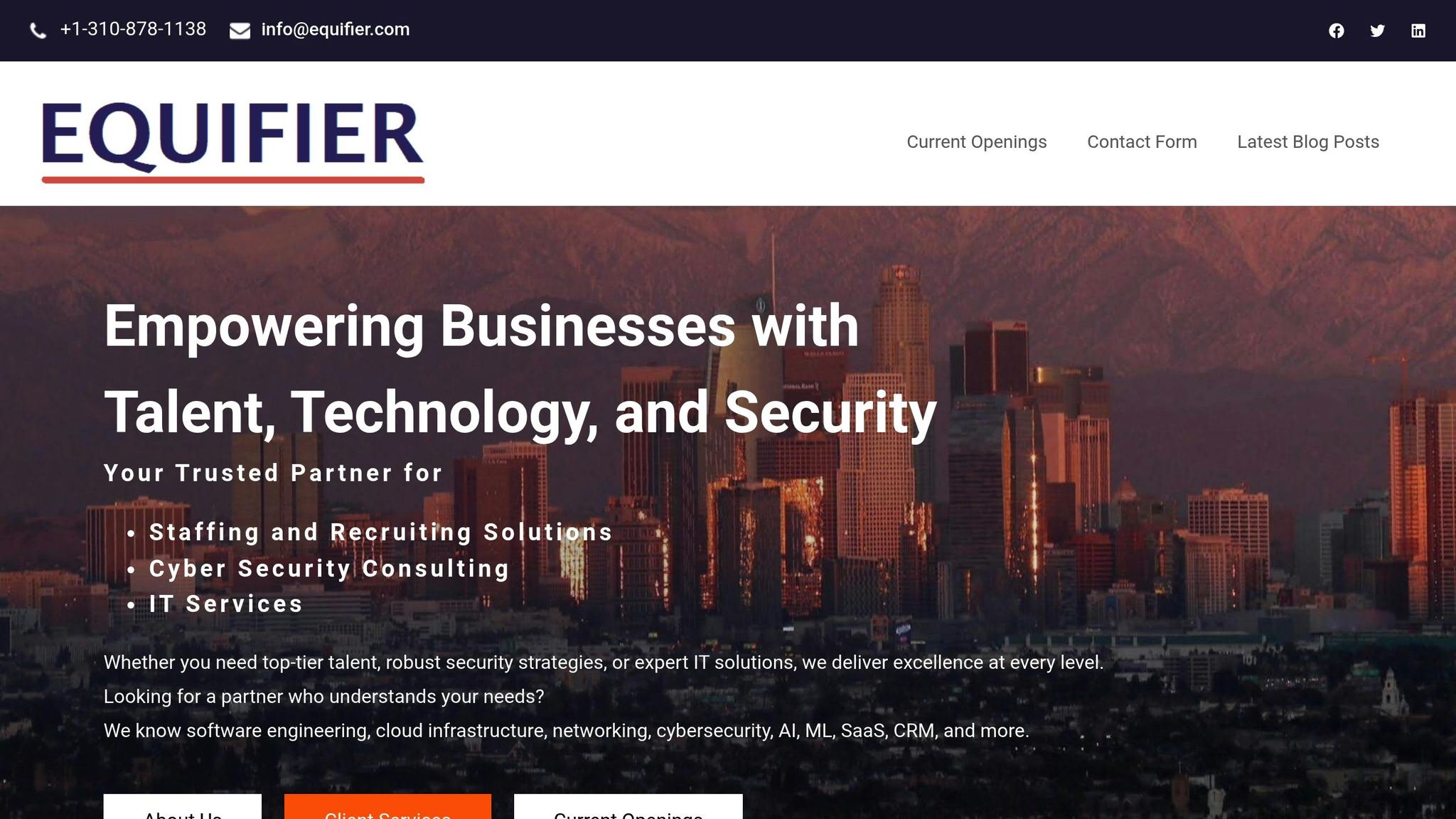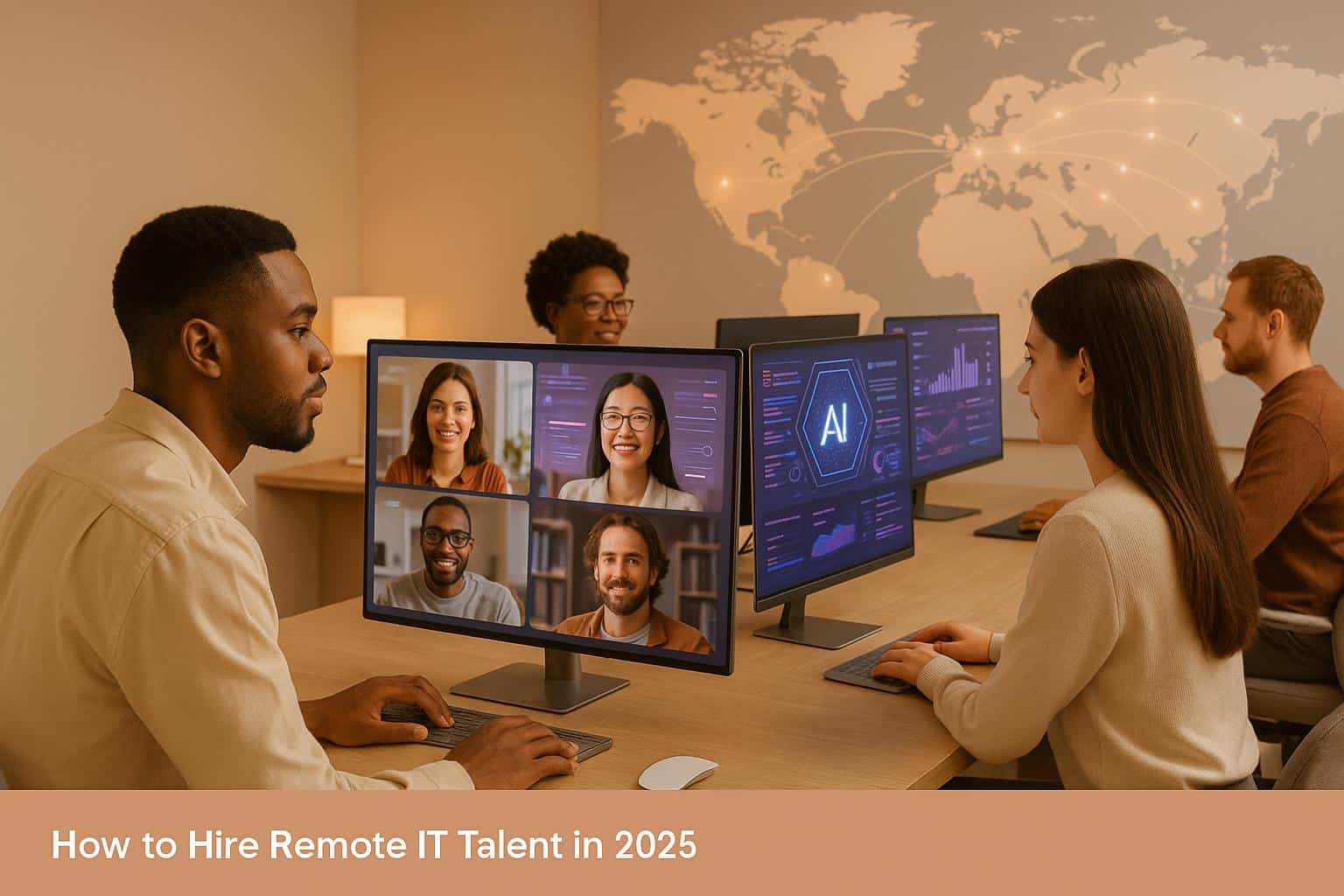Hiring remote IT talent in 2025 is all about leveraging AI tools, expanding your search globally, and addressing cybersecurity risks upfront. Here’s what you need to know:
- Use AI tools: Automate resume screening, interview scheduling, and candidate ranking to save time and improve hiring decisions. Tools like ATS and chatbots streamline the process.
- Global talent pool: Remote hiring expands your reach, but you’ll need to navigate legal and tax compliance across regions.
- Cybersecurity focus: Implement strong measures like multi-factor authentication and zero-trust models to protect your remote workforce.
- Retention strategies: Competitive pay, flexible work options, and professional growth opportunities are essential to keep top talent.
- Fair assessments: Use skills-based evaluations and unbiased AI systems to ensure equitable and effective hiring.
[Webinar] VanHack x Remote | Hiring Remote Tech Talent 101

Using AI-Powered Recruiting Tools
AI-powered tools are transforming the way companies find and hire remote IT talent by automating tasks that used to take hours. This allows recruiters to shift their focus to more strategic responsibilities. In fact, experts estimate that by 2030, AI could manage up to 75% of recruitment activities.
Automating Recruitment Processes
One of the biggest advantages of AI in recruitment is its ability to handle repetitive, time-intensive tasks. Traditionally, recruiters spent countless hours reviewing resumes, scheduling interviews, and maintaining communication with candidates. With AI, these processes become faster and more efficient. For example, research shows that recruiters spend about 13 hours a week sourcing candidates for a single role. AI tools can save three to five hours per day, boosting recruiting efficiency by 41%.
AI can process thousands of resumes in minutes, quickly identifying candidates with the right qualifications. It also takes care of scheduling interviews, managing calendars, sending confirmations, and even rescheduling when needed.
Take the L’Oréal Group, for instance. They use an AI chatbot called Mya to screen candidates for high-volume positions, cutting their time-to-hire by 30%. These automated processes work hand-in-hand with advanced tracking systems, improving accuracy and precision in hiring decisions.
Using Applicant Tracking Systems and Data Analytics
AI-powered Applicant Tracking Systems (ATS) are taking recruitment to the next level by enabling data-driven hiring decisions. These systems are widely used, with 75% of recruiters incorporating ATS into their processes. Among those, 94% report better hiring outcomes, with 86% seeing reduced time-to-hire and 78% noting higher-quality hires.
Modern ATS platforms go beyond basic resume screening. They rank candidates, match them to job openings, and analyze profiles based on skills, experience, and other key factors. They also provide predictive analytics, trend reports, and performance metrics to guide hiring decisions. For remote IT roles, integrating these systems with video interviewing tools and collaboration platforms ensures recruiters can assess both technical skills and team compatibility, regardless of location.
AI also helps reduce bias in hiring. Studies show that nearly 40% of hiring decisions are influenced by unconscious bias. By using AI, companies can make fairer decisions and promote diversity. To support this, businesses should prioritize ATS platforms that include mobile accessibility, diversity-focused tools, and bias-reduction features. Additionally, advanced systems often enhance the candidate experience with AI chatbots, automated follow-ups, and user-friendly application processes.
Equifier‘s AI-Powered Staffing Solutions

Equifier combines automation and data analytics to identify and match top-tier remote IT candidates. Their AI-powered staffing solutions streamline the hiring process, ensuring businesses find the best talent for both full-time and contract roles. By blending AI algorithms with human expertise, Equifier delivers highly accurate candidate matches.
The platform is designed to address the unique challenges of remote IT hiring. It offers access to pre-vetted professionals who are aligned with the company’s time zones and skilled in AI-related roles. Equifier also excels in technical vetting, using performance insights to ensure candidates meet specific job requirements.
With a nationwide reach, Equifier connects companies to a vast network of IT professionals across the U.S. This is particularly relevant as AI-related job postings now make up 9.5% of all software roles. Companies like JPMorgan, Citigroup, and Wells Fargo have already increased their AI workforce by 13% in just six months. Beyond technical skills, Equifier emphasizes cultural fit, ensuring candidates integrate smoothly into remote teams.
Equifier simplifies the recruitment process with role-specific screenings, immediate technical alignment, and human-led discussions. As 60% of organizations are expected to adopt AI for recruitment by 2025, Equifier’s approach positions businesses to stay competitive while securing the best remote IT talent available.
Expanding Geographic Reach and Meeting Compliance Requirements
Remote hiring opens the door to a global talent pool. With projections indicating a shortage of 85 million tech workers by 2030, looking beyond local candidates is becoming a necessity. While technology simplifies the process of finding candidates, companies must also tackle the challenges of navigating complex legal and regulatory requirements.
Building a Larger Talent Pool with Remote-First Hiring
A 2024 Eurostat survey revealed that more than half of European workers favor remote-first jobs, and this trend is mirrored worldwide. By adopting remote-first hiring practices, organizations gain access to a broader, more diverse talent pool, including professionals with specialized skills. Beyond that, companies offering remote work often attract high-performing candidates who value flexibility and prioritize work–life balance. AI-powered recruitment tools further enhance this process, streamlining how candidates are evaluated. However, with this expanded reach comes the responsibility of meeting various compliance obligations.
Managing Multi-State and Cross-Border Compliance
While AI makes it easier to source talent from different locations, it also introduces the challenge of adhering to a patchwork of legal requirements across regions. Hiring across state or national boundaries often brings unexpected complexities. Gregory Abrams, Partner at Tucker Ellis, LLP, highlights this issue:
"A major challenge confronting employers with a significant remote employee population is considering compliance with additional state laws based on where the remote employee works. A company with only one physical location in one state nonetheless could be responsible for complying with employment laws across multiple states. One-size-fits-all employment policies may prove insufficient."
In most cases, remote employees are subject to the laws of the city and state where they physically work. For instance, a California-based company hiring a developer in Texas must adhere to the employment laws of both states. While federal law prevents double taxation across states, at least six states have rules that could lead to unexpected tax obligations .
Pete Isberg, Vice President of Government Affairs at ADP, underscores the risks:
"When organizations don’t comply with the state laws where remote workers live, it can expose the organization and employee to improper tax withholding and other non-compliance liability."
To navigate these challenges, many companies are turning to solutions like Employer of Record (EOR) services, hybrid hubs, and flexible contracts to ensure compliance with labor laws and tax regulations. Establishing clear processes is key – for instance, enabling employees to easily report relocations, tracking the exact date of any move, and updating location data to ensure accurate tax reporting.
Best Practices for Fair Candidate Assessment
When hiring across regions, maintaining fairness and consistency in candidate evaluations is crucial. Assessments must align with Equal Employment Opportunity (EEO) laws and focus on job-specific skills.
Research shows that many employers prefer skills-based assessments over traditional résumés, as they provide better predictions of job performance and help reduce bias. To ensure fairness, a combination of tools – technical tests, assignments, interviews, and personality evaluations – should be used. Human oversight is essential to catch nuances that automated systems might miss. Providing candidates with clear guidelines, timelines, and feedback throughout the process, while safeguarding their data to comply with privacy regulations like GDPR and CCPA, is an integral part of best practices in hiring.
Evaluating and Interviewing Remote IT Candidates
Once you’ve widened your talent pool and ensured compliance frameworks are in place, the next hurdle is assessing candidates effectively through virtual channels. Remote interviews require a different approach compared to traditional, in-person meetings. They demand a sharper focus on both technical expertise and the soft skills necessary for success in a distributed work environment. This builds on earlier discussions about recruitment and compliance, ensuring candidates are evaluated thoroughly.
Running Effective Virtual Interviews
A successful virtual interview starts with ensuring your tech setup is solid. Test your internet connection, audio, and video on a reliable platform, and always have a backup plan in case something goes wrong. Scott Entwistle, a recruiter at Remote, shares a useful tip:
"I always recommend doing a test before an interview. Video platforms like Zoom, Whereby, Teams, and Google Meet all have their quirks, so the best way to test them is to invite a friend (or even yourself on a different device) to make sure you can successfully join a meeting."
Plan your interviews in clearly defined segments that cover soft skills, technical expertise, and behavioral insights. Prepare a concise list of key questions beforehand and provide candidates with all the details they’ll need – such as the video platform, interview duration, and who they’ll be speaking with. Creating a comfortable and distraction-free environment sets the tone for a smooth conversation. To keep energy levels high, consider scheduling breaks between interviews and limiting the number of interviews conducted in one day.
For technical evaluations, tools like Codility or TestGorilla can help assess problem-solving and teamwork. Collaborative platforms like Miro, Figma, or Google Docs can also be used to simulate real-world tasks and gauge how candidates work in a team.
Testing Technical and Soft Skills
Remote work has reshaped how candidates are assessed. As Jan Bernhart, a freelance technology recruiter, explains:
"Remote interviews demand sharper focus on soft skills."
For technical skills, live coding challenges, portfolio reviews, or trial projects are excellent methods. Automattic, for example, offers paid trial periods of 2–6 weeks where candidates work on real projects with team members for about 20 hours a week. This allows companies to see how well candidates perform in real-world scenarios and how they fit within a team.
Soft skills are equally critical. Communication, time management, and adaptability to remote collaboration are key areas to evaluate. Asking questions about how candidates handle miscommunication or work within documentation-first environments can provide insights into their readiness for remote work.
Behavioral interviews are another effective tool. Techniques like the STAR method (Situation, Task, Action, Result) help uncover traits like initiative and accountability. Companies like Zapier use scenario-based questions to assess alignment with their values, often through email-based assessments and written exercises.
A skills-focused hiring approach is gaining popularity. Statistics back this up: 72% of employers now prefer skills assessments over traditional CV reviews, and 94% believe this method better predicts job performance. Additionally, 84% of employees feel that skills-based hiring can reduce bias, even as hiring bias has reportedly risen by 48%.
Using Employee Referrals and Tech Communities
Employee referrals remain a powerful way to identify candidates who already have an understanding of your company’s culture. This complements other advanced recruiting strategies. Remote employees, in particular, often have extensive networks within tech communities, offering valuable insights into potential candidates’ abilities to thrive in a distributed work environment.
Engaging with tech communities also opens doors to passive candidates. Active participation in online forums, contributions to open-source projects, and maintaining a presence on platforms like GitHub or Stack Overflow can reveal a candidate’s technical skills and collaborative abilities. Building these relationships early ensures that when you’re ready to hire, you already have a strong pipeline of candidates who align with your work style and values.
sbb-itb-05efa2a
Cybersecurity and Remote Workforce Management
Once you’ve evaluated candidates, the next big challenge is securing your remote workforce against the growing tide of cyber threats. Why is this so critical? The numbers speak for themselves: remote work has led to a 238% increase in cyberattacks, 73% of executives believe remote workers pose a higher security risk than those onsite, and 60% of small businesses risk closure within six months of a data breach. These stats highlight why cybersecurity must be a core part of your remote hiring and management strategy.
Setting Up Strong Cybersecurity Measures
Building a secure remote workforce starts with implementing strong cybersecurity measures during hiring and onboarding. One essential step is adopting multi-factor authentication (MFA), which 75% of organizations now use to cut account compromise risks by a staggering 99.9%. Despite this, 64% of companies still lack sufficient network monitoring, leaving them vulnerable to threats. The stakes are high – data breaches in 2024 averaged $4.88 million globally, marking a 10% rise from the previous year.
Another critical approach is adopting a zero-trust model, now embraced by over 86% of organizations. This framework assumes no user or device is inherently trustworthy, requiring constant verification for every access request. Ken Kully, Cyber Tech Lead at Rockwell, captures the urgency of this approach:
"With hybrid workforces, a lot of people are bringing in, you know, devices from home, either their phones or laptops that are personal, and they’re connecting it to their operational environments. The risks involved with this aren’t going away; in fact, they’re growing."
To further secure your remote IT teams, prioritize endpoint protection, encrypted data transmission, and automated patch updates. These measures provide a solid foundation for defending against cyber threats.
Equifier’s Cybersecurity Consulting Services
Managing cybersecurity for a distributed workforce often requires expert assistance. Equifier’s cybersecurity consulting services are tailored to meet the unique needs of remote IT teams. These services include risk assessments, compliance management, and managed security solutions. For example, our experts can help you navigate complex requirements, whether it’s addressing GDPR regulations with penalties up to €20 million or 4% of global revenue, or managing multi-state compliance in the U.S.
Equifier also offers managed security services, featuring 24/7 monitoring, real-time threat detection, and incident response. This approach is particularly effective against the 98% of cyberattacks that rely on social engineering. By incorporating security assessments into the onboarding process and providing ongoing support, we help ensure your remote IT professionals are equipped to maintain robust defenses as your team grows.
But cybersecurity isn’t just about tools and services – it’s also about building awareness.
Continuous Security Awareness and Training
Hiring skilled professionals is just the beginning. To stay ahead of evolving threats, regular and targeted security training is essential. With 98% of cyberattacks leveraging social engineering tactics, educating employees on how to recognize and respond to these threats can significantly reduce risks.
Effective training programs go beyond a one-time onboarding session. Role-specific modules can teach HR teams to spot phishing emails, help finance teams verify payment requests, and guide developers in secure coding practices. Adaptive training platforms and weekly cybersecurity reminders can also help maintain a culture of vigilance. For example, phishing simulations coupled with bite-sized learning modules provide hands-on experience. This is crucial, considering businesses in Australia alone lose an estimated $2.9 billion annually to Business Email Compromise (BEC) attacks.
Adam Keisling, HSI IT Senior Director, highlights the importance of ongoing vigilance:
"In our interconnected world, vigilance against cybersecurity threats has never been more crucial, especially in times of stress and uncertainty… Cybersecurity isn’t a one-time solution, it’s an ongoing commitment to safeguarding our personal information, our privacy, and our financial data. Only by embracing best practices can we create a more secure digital future for all."
To boost engagement, consider recognizing employees who report phishing attempts or hosting monthly security challenges with small rewards. Additionally, establish clear policies for BYOD (Bring Your Own Device) and public Wi-Fi usage. Provide remote IT professionals with guidelines on securing home networks, using company-approved VPNs, and identifying threats like unfamiliar pop-ups or unauthorized software installations. These steps help create a proactive and informed workforce, ready to tackle cybersecurity challenges head-on.
Keeping Remote IT Talent Long-Term
Once you’ve secured your remote IT team, the next hurdle is keeping them around. With competition for skilled professionals at an all-time high, 31% of organizations cite unfair pay as the top reason for talent loss. Add to that the fact that employee engagement in the U.S. hit a decade low of just 31% in 2024, and it’s clear that retaining remote IT professionals demands a thoughtful approach. Competitive pay, flexible work arrangements, and a sense of belonging are all critical pieces of the puzzle.
Creating Competitive Compensation Packages
A strong compensation package goes beyond just a paycheck. It should include base salary, performance bonuses, meaningful benefits, and flexible perks. In fact, nearly 60% of employees rank benefits as one of the most important factors when deciding on a job.
Salary transparency is now the norm. Research shows that 91% of job seekers are more likely to apply when salary ranges are included in job postings. Many companies are adopting transparent pay structures, adjusting salaries based on location, and using detailed calculators to ensure fairness.
Performance bonuses can also make a big difference. They’re not just financial incentives – they’re engagement boosters. Employees receiving bonuses are eight times more engaged and report an 8% increase in job satisfaction. Offer bonuses tied to clear, measurable goals, such as quarterly performance milestones, project completions, or annual retention incentives for top performers.
Your benefits package should reflect the needs of remote workers. This means providing health insurance, dental and vision coverage, retirement plans with company matching, and even personalized stipends that let employees choose the perks that matter most to them.
Lexi Clarke, Chief People Officer at Payscale, sums it up well:
"In this environment, listening to employees and leading with fairness isn’t just the right thing to do – it’s a competitive advantage. A cooling labor market, rising pay transparency and the potential for an economic rebound could reignite the battle for top talent. Companies that invest in compensation strategy and prioritize equitable practices will be best positioned to attract, retain, and empower their workforce."
Providing Flexibility and Professional Growth
Flexibility isn’t just a perk – it’s a necessity. 83% of employees say work-life balance is crucial, and remote IT professionals particularly value the freedom that comes with remote work. By cutting out commutes, developers save an average of 72 minutes a day, freeing up time for personal growth or relaxation.
Offer flexible work arrangements tailored to individual needs. This could mean setting core collaboration hours while allowing flexible start and end times, compressed workweeks, or project-based schedules. Giving employees some control over their workload matters too – 43% of workers are less likely to feel burnt out when they can choose which tasks to focus on.
But flexibility alone isn’t enough. Professional growth opportunities are just as important. 94% of employees say they’d stay longer at a company that invests in their learning and development. Support your team with clear career progression paths, access to online courses, reimbursement for certifications, and budgets for attending industry conferences. Internal mentorship programs can also make a big impact – nine out of 10 workers with mentors report being happier in their jobs.
Set measurable, challenging goals for your remote IT professionals. Studies show that people with specific goals outperform those with vague objectives by up to 90%. Regular one-on-one meetings should go beyond project updates to include long-term career planning and skill-building discussions.
To maintain productivity and prevent burnout, promote techniques like the Pomodoro Technique, which alternates 25-minute work intervals with short breaks. This method alone can boost productivity by up to 31%. Encourage clear boundaries between work and personal time to help your team stay energized.
Building an Inclusive Remote Culture
Fostering a sense of belonging in a remote team requires consistent effort. 39% of job seekers have declined opportunities due to a perceived lack of inclusion, and the same holds true for retaining existing employees. A welcoming culture starts with clear communication and equal access to resources and opportunities. Employees who feel heard are 4.6 times more likely to be empowered to do their best work.
Make recognition a priority. Only one in three employees feel they receive consistent acknowledgment for their efforts. Recognition should be specific, timely, and public. Encourage managers to highlight individual contributions regularly, focusing on achievements rather than generic praise.
To strengthen team bonds, offer diverse virtual team-building activities. While some employees might enjoy casual virtual coffee chats or online games, others may prefer asynchronous options like book clubs or discussion forums. Empathy is key – 78% of employees say they’d work longer hours for a more empathetic employer. Train managers to lead with emotional intelligence and understanding.
Employee Resource Groups (ERGs) can also thrive in remote environments. These groups provide support networks and help identify areas for improvement in your inclusion efforts. For example, Guild’s partnership with Paradigm led to a 30% increase in employee understanding of DEIB (diversity, equity, inclusion, and belonging) goals through a mix of online and in-person training sessions.
Encourage cross-functional collaboration to break down silos and build stronger connections. Activities like internal tech talks, code reviews, or innovation challenges bring team members together and combat the isolation that sometimes comes with remote work.
Daniella Bellaire, Global Head of Enablement at Shopify, explains the value of collaborative learning:
"Remote learning does not mean independent learning. If you are someone who learns by talking through problems and ideas, then pairing up with peers is a great way to learn together and challenge each other. This also helps with engagement and relationship building as a bonus."
Building an inclusive remote culture is an ongoing process. Regular surveys, focus groups, and informal check-ins can help you identify areas for improvement. Beyond the cultural benefits, retention pays off financially – disengaged employees cost U.S. businesses roughly $1.9 trillion in lost productivity. Investing in retention strategies is not just good for your team – it’s essential for your bottom line.
Key Takeaways for Hiring Remote IT Talent in 2025
In 2025, hiring remote IT talent means combining cutting-edge technology with human insight. AI-powered recruiting tools are at the heart of this transformation. Companies using these tools report hiring 25% faster while cutting costs by 30% on average. Additionally, AI-driven solutions have boosted recruiters’ capacity by 54%. To tackle hiring challenges effectively, choose tools that offer features like intelligent automation, predictive analytics, and scalability.
The results speak for themselves. Take Chipotle, for example: when hiring for 20,000 seasonal roles, their application completion rate soared from 50% to 85%, and their hiring time dropped from 12 days to just 4. Sean Behr, CEO of Fountain, highlights the advantage of AI in hiring:
"The AI agent is designed to figure out if you’re a good fit for the job, and frankly, I think it does a better job than humans. It does it faster and more effectively, and it does it in a bias-free way."
Navigating Compliance in a Remote World
Expanding your hiring reach comes with legal complexities. Employment laws are tied to the employee’s location, and keeping up with changing regulations across jurisdictions can be overwhelming – 63% of decision-makers admit to struggling in this area. To avoid legal pitfalls, integrate legal oversight and conduct regular audits. Misclassifying workers or missing regulatory updates can lead to serious consequences. Employment attorney Kara Maciel from Conn Maciel Carey LLP explains:
"The biggest challenge employers face with a distributed workforce is keeping track of the different and ever-changing state and local laws that apply to each employee based on where they are physically working."
Cybersecurity and Workforce Management from Day One
Remote work expands the potential for cyber threats, so robust data protection is non-negotiable. Begin implementing cybersecurity measures during the hiring process and ensure compliance with data protection laws. Clearly outline policies on time tracking, breaks, and off-the-clock work to avoid wage violations. Embedding these practices into onboarding helps protect your remote workforce from the start.
Retention: The Key to Long-Term Success
Retaining top IT talent depends on more than just hiring the right people – it requires competitive pay, flexible work options, and a supportive, inclusive culture. These elements are critical for keeping employees engaged and ensuring their long-term success in your organization.
Balancing AI and Responsibility
The use of AI in hiring demands careful consideration. As Trey Causey, Senior Director of Responsible Technology at Indeed, puts it:
"Responsible AI use doesn’t mean avoiding AI – it’s about balancing risks and opportunities. The real danger lies in either ignoring AI or adopting it recklessly – both diminish your ability to do your job effectively."
Striking this balance allows organizations to harness AI’s potential without compromising fairness or effectiveness.
With 74% of employers struggling to find skilled tech talent, partnering with experts who understand both the tech and human sides of remote hiring is more important than ever. Companies like Equifier offer AI-driven staffing solutions, compliance support, and cybersecurity consulting to address these challenges head-on. Success in 2025 will belong to those who embrace these tools thoughtfully and strategically.
FAQs
How can AI tools help make hiring remote IT talent more fair and unbiased?
AI tools have the potential to improve equity in hiring by emphasizing objective data over subjective opinions. These tools evaluate candidates based on their skills, experience, and qualifications, steering clear of unconscious biases tied to factors like race, gender, or age.
On top of that, AI can help establish standardized interview processes by crafting uniform questions for all applicants. This ensures everyone is judged against the same criteria. By automating early-stage screenings and assessments, these tools minimize human error and contribute to a more inclusive hiring approach, particularly for remote IT roles.
What are the main legal and tax challenges when hiring remote IT professionals across different states?
When recruiting remote IT professionals from different states, businesses face legal hurdles tied to state-specific employment laws. These include meeting wage standards, following overtime rules, and accurately classifying workers as either employees or contractors. Missteps in classification can result in hefty fines, making compliance a top priority.
On the tax front, companies must tackle challenges like state income tax withholding, potential nexus complications, and obligations across multiple states – especially when employees are spread across various locations. To sidestep expensive errors and maintain seamless operations, it’s wise to engage legal and tax experts for proper guidance.
What are the key cybersecurity practices to safeguard a remote IT workforce in 2025?
To safeguard your remote IT team from cybersecurity threats, start by ensuring multi-factor authentication (MFA) is in place. This adds an extra layer of protection. Pair it with strong, unique passwords for all accounts, and secure internet connections through virtual private networks (VPNs). These steps help keep unauthorized access at bay.
Regular cybersecurity training is equally important. Teach employees how to spot phishing emails, suspicious links, and other typical threats they might encounter. Awareness is often the first line of defense.
It’s also wise to invest in endpoint security solutions to protect the devices that connect to your network. Make sure all software is updated promptly with the latest security patches. These updates often address vulnerabilities that hackers could exploit.
By combining these strategies, you’ll build a strong shield against the ever-changing landscape of cyber threats in remote work settings.









